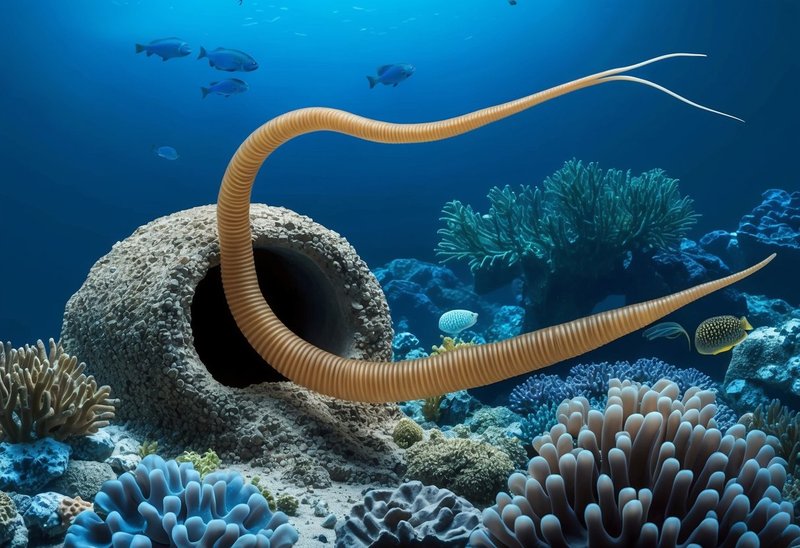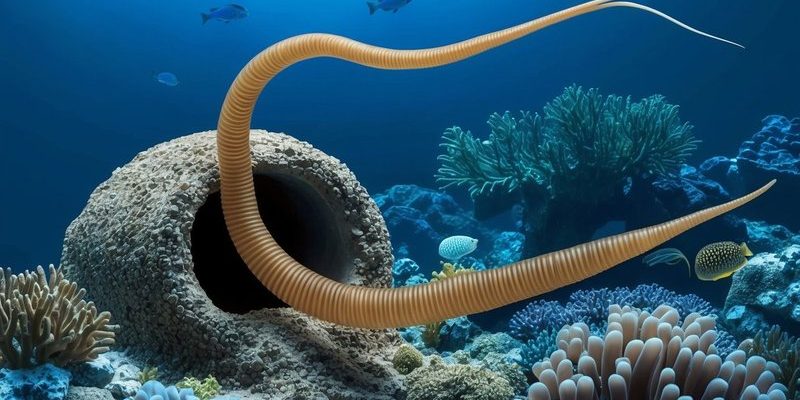
Bobbit worms, or *Eunice aphroditois*, aren’t your everyday sea critters. With their long, segmented bodies that can reach up to ten feet, they can be both fascinating and fearsome. Think of them as the stealthy ambush predators of the reef, waiting to snatch unsuspecting prey with their sharp, powerful jaws. But do they pose a danger to coral reefs? Let’s take a closer look and find out.
What Are Bobbit Worms?
Bobbit worms are fascinating creatures that belong to the polychaete family of annelids. Typically found in the warm waters of the Indo-Pacific region, these worms are most often spotted burrowed into sandy or muddy substrates. They’re experts at camouflage, often hiding their bodies while only the head—with its antennae and jaws—sticks out.
One unique feature of Bobbit worms is their ability to move quickly and strike with lightning speed. When prey comes too close, they can easily launch themselves out of their burrows. This predatory behavior definitely makes them one of the reef’s more interesting residents, but it also raises questions about their impact on the ecosystem.
Bobbit Worms and Coral Health
So, here’s the thing: while Bobbit worms are predators, they don’t typically prey on corals directly. Instead, they feast on smaller organisms like fish, crustaceans, and mollusks. Their presence might actually help keep some of the populations of these creatures in check, contributing to a balanced ecosystem.
However, bobbit worms can disrupt the reef environment *indirectly*. When they hunt, they can cause significant disturbances in the sediment and substrate, which might affect coral health. Coral reefs thrive on stability. If predators like Bobbit worms create chaos in their surroundings, it can negatively impact the delicate balance that keeps the corals thriving.
The Balance of Ecosystems
In nature, balance is crucial. Bobbit worms fit into the food web, just like any other predator. They’re part of a larger ecosystem where every creature has a role to play, and that includes maintaining the health of coral reefs. While they can disrupt the sediment, they also provide food for larger predators, keeping a circle of life going.
An ecosystem’s resilience often depends on how well different species coexist. For example, if the populations of smaller fish decline due to increased Bobbit worm activity, it could lead to overgrowth of algae and other organisms that compete with corals. If left unchecked, this can negatively impact coral health.
Potential Threats from Bobbit Worms
While Bobbit worms aren’t direct predators of coral, they can present certain threats as part of the intricate web of life on a reef. Here are a few ways they can impact coral ecosystems:
- Disturbance of Sediment: As they hunt, their burrowing can cause sediment to stir up, which might smother corals and block sunlight.
- Prey Competition: By preying on certain reef species, they could reduce the populations of those fish that help maintain coral health.
- Disruption of Biodiversity: A significant increase in Bobbit worm populations might lead to an imbalance in species diversity, which is crucial for a healthy reef ecosystem.
It’s important to note that while Bobbit worms can be problematic, they aren’t the sole culprit behind coral reef issues. Overfishing, pollution, temperature changes, and ocean acidification also play central roles in coral decline. Bobbit worms are just one piece of a much bigger puzzle.
Bobbit Worms vs. Coral Predators: A Comparison
When you think about threats to coral reefs, Bobbit worms share the spotlight with other notorious predators. Here’s how they stack up against a few other reef adversaries:
| Predator | Impact on Coral |
|---|---|
| Bobbit Worms | Indirect disruption; primarily hunt fish and invertebrates. |
| Crown-of-Thorns Starfish | Directly consume coral polyps, can devastate reefs at high population levels. |
| Parrotfish | Graze on coral, but also help control algae growth; complex role in reef health. |
As you can see, each predator has its unique role in the ecosystem, and understanding these positions can help us find ways to protect coral reefs effectively.
Conservation and Its Importance
Understanding the role of Bobbit worms in coral reef ecosystems is vital for effective conservation efforts. These worms highlight the complex interactions that occur in marine environments. By focusing on preserving biodiversity and ecosystem balance, we can help coral reefs thrive despite the challenges they face.
Conservation efforts should also involve monitoring Bobbit worm populations and their impact on local marine life. Engaging in sustainable practices like reducing pollution and protecting habitats can help maintain the health of coral reefs while allowing creatures like Bobbit worms to play their part in a balanced ecosystem.
Final Thoughts on Bobbit Worms and Coral Reefs
Bobbit worms are indeed fascinating, but they serve as a reminder of the delicate balance within coral reefs. While they might not pose a direct threat to corals, their presence can influence the health of these important ecosystems in various ways.
If we want to preserve the beauty of coral reefs for future generations, we need to understand all the players in this underwater drama, including the Bobbit worm. The more we learn about these creatures, the better equipped we’ll be to protect coral reefs and the incredible diversity of life they support. So the next time you hear about Bobbit worms, you’ll know they’re part of a larger picture, one that we have to keep healthy and thriving.

